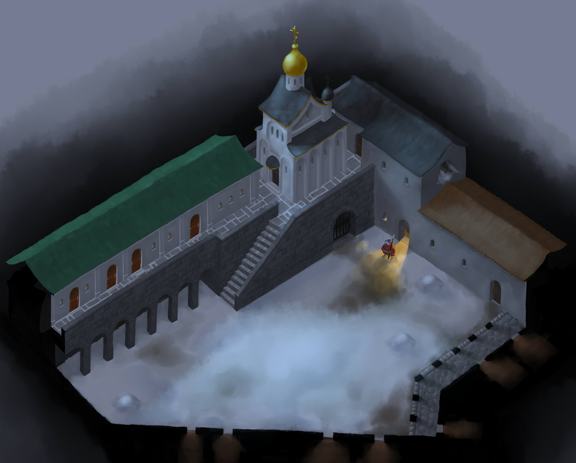Hello again!
As I was saying, Easy Paint Tool SAI is remarkably different of other painting software, but now let me explain it better. Among those fundamental differences is the Water brush. Unfortunately I jut can’t tell exactly what makes this brush so special, even 2 months after my first contact with it and the intensive work I’ve done in it in the last weeks. The fact is that it is simply different of any brush I’ve used in Photoshop and Painter. To give you an idea it’s similar to the Artist’s Oil brush in Corel Painter, the one, by the way, that I used most until now. But Water has an unique dynamic of use, it’s trace just flows, it can vary opacity, color and width by pen’s pressure, and it blends and changes the colors already in the canvas in a awesome way. To show you a little about this dynamics I’ll present now a simple walk through of one of the Concepts I’ve been working on, an Outside Yard of the Moscow Kremlin Palaces.
In the first step I’ve traced the plan of the two stories of buildings that would be done, I’ve used just the Water brush with Noise at this point.
After that I’ve started the illustration proper. It was done using some layers, as it would be useful have the concept being modular and flexible, being able to represent both outside and inside areas. One of the main goes of this concept was to map tilesets, the pieces of patters and textures that can be applied on surfaces, making easier to cover big areas. In this case it happened specially in the ground, the roofs and in stonewalls, where the tiles where used in a much more loose way then normally it’s done, not having geometric precise limits and normally leaving gaps that I would fill manually. I’m considering using this same loose system in the final graphics of the game.
Now to SAI’s high point, in my opinion: lighting. It has some features of layer blending that are really amazing. The one that caught my attention in the first glance was Lumi&Shade, great to create both projected light and enlightened objects. As the name suggests, it blends luminance and hue, helping in creating nice lighting effects. Another essential is PassTrought, that is applied to layer groups and allows each layer’s blending mode to interact with the layers outside the group. It’s quite important to allow the layers being properly organized.
So, at the end of 3 weeks of work (during which I’ve been creating 3 other background concepts, helping Bruno and Ingrid create the character’s color test vector files and already doing some of those color tests myself), the result of the Outside Yard is this:
Now I’ve gotta go, my trial period with SAI is running out and I must go buy it to continue my work. Incidentally, one more good thing about it: a single license costs just 50 dollars.
See you soon!



